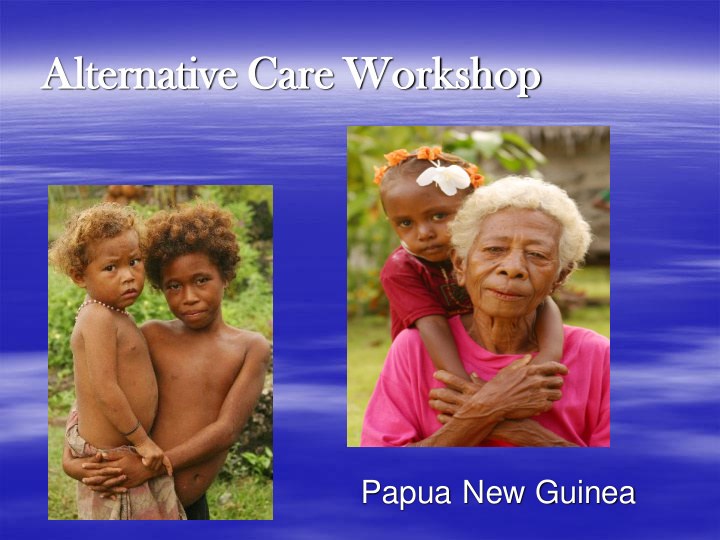



Altern rnat ative ve Care re Work rksho hop Papua New Guinea
The Three Logs Story…
Papua New Guinea
Situation of children without primary caregivers ▪ 8% of children are double orphans (Children on the Brink) ▪ 22.4% of children were not residing with their parents in 2000 (Census). ▪ 10,000 children live on the street, up to half of whom live in the Nation’s Capital (Hunter). ▪ High rate of informal adoptions and fostering (up to 16% of households have step or adopted children) (Census)
Double Orphans by Type 8% in PNG, 2003 Source: Children on the Brink Maternal 2004 35% Paternal 57%
Situation (cont) ▪ 9400 children orphaned as a result of HIV/AIDS (Hunter). ▪ 138,108 children living in families affected by HIV/AIDS (Hunter). ▪ Abandonment of children remains rare, but is increasing under the threat of the HIV/AIDS epidemic (e.g. single parents who are not confident that they can care for a child with HIV/AIDS)
Situation (cont) Fostering and Adoption in Papua New Guinea may take place informally because: ▪ Single parents may feel unable to care for the child ▪ To maintain gender balance within the family ▪ A peace-building effort between tribes ▪ Marriage breakdown or death of parent ▪ Early marriage of the child (sometimes as young as 12 years of age)
Situation (cont) ▪ Fostered/Adopted children are often more vulnerable because: – Some children are separated from their mothers whilst still breastfeeding. – Children residing outside of their wantok are perceived to have a lower status in their new family, and are at greater risk of abuse and exploitation. – Some families feel pressured to take on the care of child, even if it is beyond their financial resources. – These children rarely receive any psychosocial support.
Situation (cont) Children living on/off the street: ▪ Estimated 1000-5000 street children in Port Moresby. ▪ 89% male, 11 % female ▪ Majority are between 10-15 years of age ▪ Live off an average of 1-2 kina per day (appox..32-0.65). (Hunter)
Residential/Institutional Care Programs ▪ Rare in Papua New Guinea. ▪ New draft legislation discourages this model of alternative care. ▪ Some quasi-residential community care centres are being developed in communities with high numbers of children who are orphaned as a result of HIV/AIDs.
Residential/Institutional Care Programs (cont) ▪ Example: Tengtenga Orphans Care Centre (WHP) – 39 orphans – reports that community attitudes encourage stigmatisation and isolation of the children. – Some orphaned children are being exploited by family or care-givers.
Non-residential Care Models ▪ Erosion of the traditional Wantok system has resulted in reduced extended family support. ▪ Child-headed households are becoming more common. ▪ 2000 census identified approximately 5.2% of children as “fostered or step.” ▪ If those residing with adults who are “other relatives” or “not related,” this figure rises to 22.4%.
Proportion of PNG households with step or adopted children 10.0 9.0 8.0 7.0 6.0 5.0 4.0 3.0 2.0 1.0 0.0
Non-residential Care Models (cont) ▪ Majority of adoptions are done under traditional arrangements and without formal recognition. ▪ Reasons include: – reinforcing family ties – caring for orphaned children – family unable to financially support child – balance family size/gender ratio – to provide help to older relatives ▪ Without adequate birth registration, it becomes difficult to track the movements of these children.
Govt Response to Date ▪ Enabling legislation & policy – Draft Lukautim Pikinini Act – Juvenile Courts Act (and new draft Juvenile Justice Act) – National Disability Policy (draft) – Education Policy (prioritizes vulnerable children) – Proposed new National Child Policy can provide overarching framework – Legislation will be reviewed in 2006. ▪ Orphaned children currently do not have access to psychosocial or placement monitoring support services.
Constraints and Lessons Learned ▪ HIV/AIDS Epidemic – Prevention is an ongoing challenge. – Some predictions suggest up to 13% of the adult population will be infected by 2010. – Less than 10% of those with HIV/AIDS are aware of their status. – Poor health services at primary, secondary and tertiary levels – Capacity for timely positive changes at the community level (Three Logs Story).
Constraints and Lessons Learned ▪ Lack of accurate data – Low birth registration – Low rates of HIV/AIDS identification – High levels of informal and unrecorded alternative care models.
Constraints and Lessons Learned Many aspects of the current informal fostering and adoption systems provide a protective safety net for vulnerable children, however there is a need to influence the current systems to become more child- centered to ensure that the rights of the children in alternative care are respected.
Recommendations ▪ Support and strengthen existing clan-level safety nets. ▪ Promote a child-centered, human rights based approach to informal fostering/adoption. ▪ Review and amend relevant legislation. ▪ Monitor the “mushrooming” of care centres and support the replication of good models already developed by local communities. ▪ Building issue of orphaned children into the proposed National Child Policy.
One Blood Examples of Alternative Care in Papua New Guinea
“ They are my wantoks. We are one people, one colour, one blood .” – Community leader, Poi Village
Shalom Care Centre
Tengatenga ‘Orphanage’
Kartanim Care Centre
Kenan Care Centre
Peace Care Centre
Recommend
More recommend